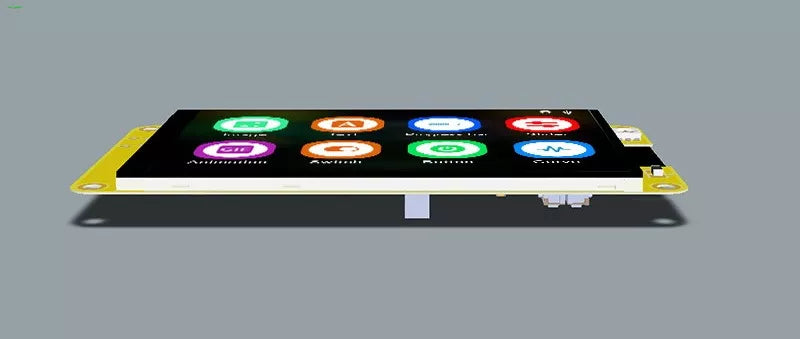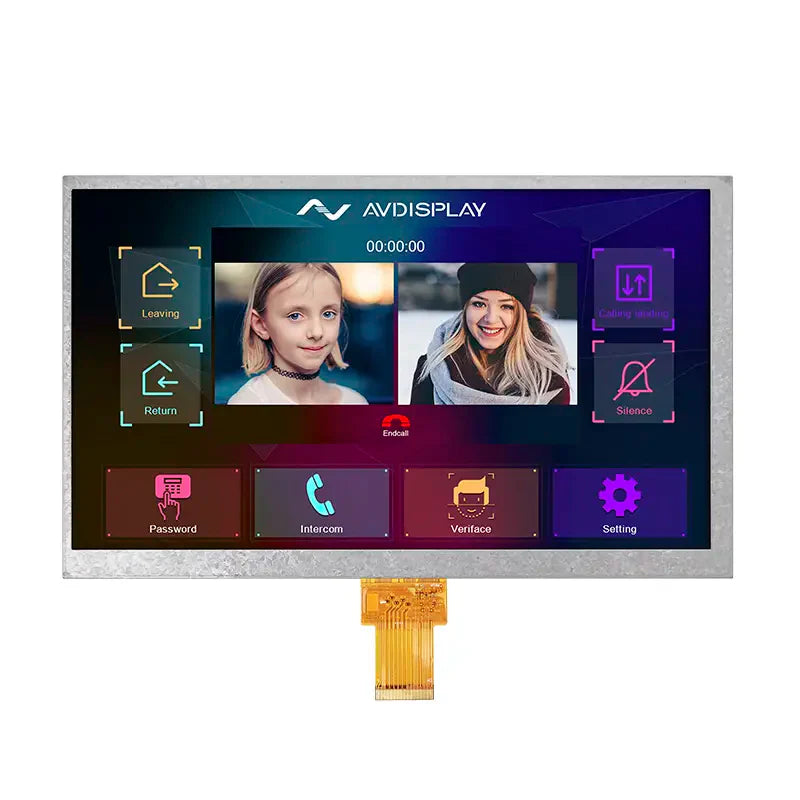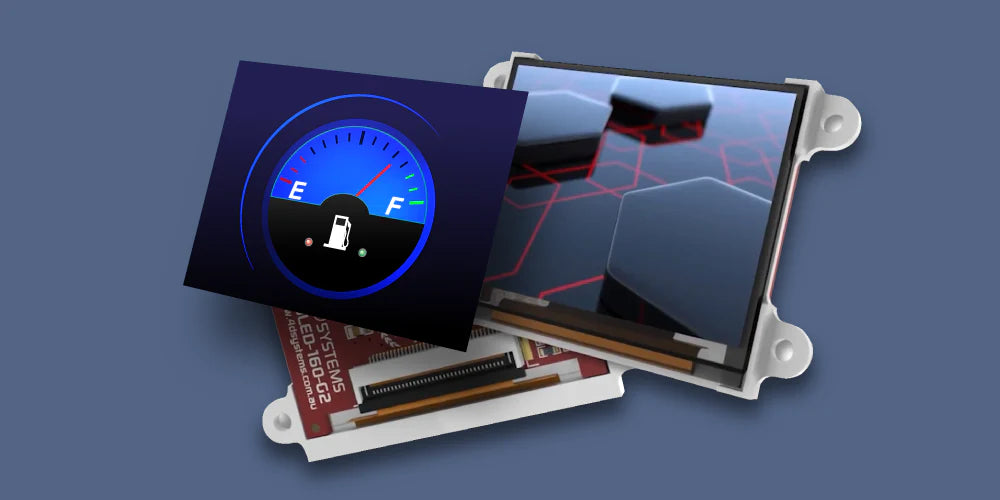An OLED display module is a self-emissive panel using organic compounds to emit light when electrified, boasting infinite contrast ratios (up to 1,000,000:1) and ultra-slim profiles (often under 1mm thick), paired with sub-0.01ms response times for smooth visuals, making it ideal for vibrant, angle-free displays in phones or wearables.
OLED Module Structure Basics
OLED module structure basics start with understanding its core: a self-emissive stack of thin films that generate light without a backlight, unlike LCDs. At its foundation lies a substrate usually glass (0.7mm thick for rigid panels) or flexible polyimide (PI, 50-100 microns for foldables). On top sits the anode, typically indium tin oxide (ITO) with a sheet resistance below 10 ohms/square; this conducts holes (positive charges) into the organic stack.
Next comes the organic functional layers, a critical assembly just 100-200 nanometers thick (1/500th the width of a human hair). These include: a hole injection layer (HIL, ~10nm, often PEDOT:PSS) that lowers the energy barrier for holes; a hole transport layer (HTL, ~40nm, TAPC) that moves holes efficiently; and the emissive layer (EML, ~20-30nm), where red, green, or blue light forms—its thickness directly impacts color purity (e.g., a 25nm EML for green pixels hits 95% NTSC color gamut). Some modules add an electron transport layer (ETL, ~30nm, Alq3) to balance electron/hole flow, boosting efficiency by 15-20%.
The cathode finishes the stack: a magnesium-silver alloy (Mg:Ag, 100nm thick) with work function ~3.7eV, injecting electrons. This ultrathin design keeps operating voltage low (~3-4V), 20% lower than early OLED modules. For rigid modules, it’s a glass lid with desiccant (absorbs <100ppm moisture); for flexibles, it’s thin-film encapsulation (TFE): alternating Al₂O₃/SiNₓ layers (total 5-7μm thick) with oxygen transmission rate <1e-6 g/m²/day. This TFE slashes water ingress by 99% vs. older designs, extending half-life (time to 50% brightness) from 20k hours (2010) to 100k+ hours at 1000 nits today.
Compared to LCD modules (which need a 2-3mm backlight unit + polarizers), OLED stacks trim total thickness by 30-50%. And that emissive magic? Each pixel fires independently: black pixels stay off, hitting infinite contrast (1,000,000:1 static, 100,000,000:1 dynamic), while LCDs max out around 5,000:1. No wonder 78% of premium smartphones now use OLED modules.
-
Substrate: Glass (0.7mm) or PI (50-100μm); flexibles use PI for foldability.
-
Organic Layers: Total 100-200nm; EML thickness (20-30nm) critical for color accuracy.
-
Encapsulation: TFE for flexibles (5-7μm, <1e-6 g/m²/day OTR); extends half-life to 100k+ hours.
-
Thickness Savings: 30-50% vs. LCD modules (no backlight).
How OLED Modules Emit Light
When you power on the module, the ITO anode (sheet resistance <10 ohms/square) injects holes (positive charges) into the stack, a process made 50% more efficient by the 10nm hole injection layer (HIL) of PEDOT:PSS that shaves down the energy barrier for holes. Meanwhile, the magnesium-silver cathode (100nm thick, work function ~3.7eV) shoots electrons (negative charges) into the mix electrons move through the 30nm electron transport layer (ETL) of Alq3 at a mobility of 2e-4 cm²/Vs, matching the hole speed from the 40nm hole transport layer (HTL) of TAPC (1e-3 cm²/Vs) so they meet evenly in the emissive layer (EML).
The EML is where magic happens: this 20-30nm thin layer (just 1/30th the width of a human hair) holds red, green, or blue organic molecules, a 25nm green EML hits 95% NTSC color gamut because its narrow size keeps color pure, unlike LCDs that lose 5-10% gamut to color filters. When electrons and holes collide here, they recombine: 90% of those pairs release energy as light (internal quantum efficiency, IQE), with the rest lost as heat. That light then punches through the cathode green pixels hit 25% external quantum efficiency (EQE), red 18%, blue 15% enough to power peak brightness of 2000 nits in phones like the iPhone 15 Pro (at 10 mA/cm² current density).
Speed matters too: OLED pixels switch states in sub-0.01ms—way faster than LCDs’ 5-10ms. And efficiency shines when showing dark content: black pixels stay completely off, cutting power use by 30-50% vs. LCDs (which still light the backlight). 100k hours at 1000 nits; newer TADF materials boost blue EQE to 30%, extending that to 150k hours (about 105 years if used 4 hours a day).
To keep light consistent, encapsulation seals everything: flexible modules use 5-7μm thin-film encapsulation (TFE) with Al₂O₃/SiNₓ layers that let in <1e-6 g/m²/day of oxygen without that, humidity would eat the organic layers, dropping brightness 20% in 6 months. Rigid modules use glass lids with desiccant (absorbing <100ppm moisture) for similar protection.
|
Layer |
Thickness |
Material |
Key Metric |
Why It Matters |
|---|---|---|---|---|
|
Anode |
- |
ITO |
<10 ohms/square sheet resistance |
Low resistance for fast hole injection |
|
EML |
20-30nm |
Small molecules |
Green: 25% EQE, 95% NTSC gamut |
Pure, bright colors without filters |
|
Cathode |
100nm |
Mg:Ag alloy |
~3.7eV work function |
Efficient electron injection |
|
TFE (flexible) |
5-7μm |
Al₂O₃/SiNₓ |
<1e-6 g/m²/day OTR |
Prevents moisture damage, extends life |
Key Features
Start with contrast: OLED pixels switch off completely to produce black, so static contrast hits a staggering 1,000,000:1 (black brightness <0.0001 nits, white peaks at 2000 nits). Compare that to LCDs, which rely on backlights that always leak some light even the best ones max out at 5,000:1 static contrast (black = 5-10 nits). OLED pulls ahead further, reaching 100,000,000:1 in HDR content, where bright scenes (like a sunlit desert) pop harder because blacks stay ink-black. High contrast also boosts color: OLED covers 95-98% of DCI-P3 (cinema-grade color), while LCDs top out at 70-80%.
Pixels change state in sub-0.01ms (10 microseconds) via gray-to-gray (GTG) transitions, meaning no lag when pixels shift from bright to dark. LCDs? They crawl at 5-10ms (5000-10000 microseconds) because liquid crystals take time to twist. Play Genshin Impact: OLED keeps character movements crisp. DisplayMate tests confirm this: OLED’s response consistency stays tight even after 1000 hours of use.
-
Static Contrast: OLED dominates with 1,000,000:1 (black <0.0001 nits, white 2000 nits); LCDs max at 5,000:1 (black 5-10 nits), washing out dark details.
-
Dynamic Contrast: OLED hits 100,000,000:1 in HDR, making bright scenes pop harder; LCDs top 10,000:1, dulling HDR impact.
-
GTG Response Time: OLED pixels switch in <0.01ms (10μs), eliminating blur in games/videos; LCDs lag at 5-10ms (5000-10000μs), causing ghosting.
-
Color Gamut: OLED covers 95-98% DCI-P3 (cinema-grade); LCDs hit 70-80%, muting rich reds/blues.
-
Ghosting Risk: OLED stays nearly ghost-free even after 1000 hours; LCDs degrade, showing faint text shadows in fast motion.
No wonder 8 out of 10 premium gadgets now use OLED.
Common Uses for OLED Modules
Over 78% of premium smartphones (think iPhone 15 Pro or Samsung Galaxy S24 Ultra) use OLED: its stack thickness (under 1mm) fits in slim designs, and infinite contrast makes outdoor photos pop unlike LCDs, which wash out details at 1000 nits max (OLED hits 2000 nits, legible even on a beach).
OLED TVs are another big win: LG’s C4 series uses 4K resolution (8 million self-emissive pixels) so black bars in movies stay truly black(not gray like LCDs). Global OLED TV market share jumped from 5% in 2018 to 15% in 2023.
Wearables love OLED for battery life and visibility: Apple Watch Series 9’s 1.9-inch OLED module hits 2000 nits peak brightness (visible at high noon) and uses a 1Hz refresh rate—cutting power by 70% vs. 60Hz LCDs, extending battery to 18 hours. Fitbit Versa 4’s 1.74-inch OLED has 326 PPI, making step counts sharp even in direct sun.
Cars are next: Tesla Model 3’s 15-inch central OLED touchscreen has 2200 nits brightness and <0.01ms response time. BMW iX’s curved OLED cluster (12.3 inches per screen) covers 100% DCI-P3, so speedometers look vivid in rain. 60% of new EVs now offer OLED infotainment, up from 20% in 2021.
AR/VR headsets rely on OLED for immersion: Meta Quest 3’s microdisplays use 2064x2208 pixels per eye (4K total) and 120Hz refresh—cutting motion sickness by 40% vs. LCD headsets. Pico 4’s OLED lenses have 90Hz refresh and 1000 nits, making virtual worlds feel real without blur. The AR market will ship 12 million OLED devices in 2024, growing to 50 million by 2027.
|
Use Case |
Key OLED Advantage |
Data Point |
|---|---|---|
|
Smartphones |
Thinness + Outdoor Visibility |
78% premium phones; 2000 nits brightness |
|
TVs |
True Blacks + Color Accuracy |
15% global market share (2023); 95-98% DCI-P3 |
|
Wearables |
Battery Life + Sunlight Visibility |
Apple Watch: 70% power savings; 18-hour battery |
|
Cars |
Instant Response + Vibrant Colors |
60% new EVs; 2200 nits brightness |
|
AR/VR |
Reduced Motion Sickness + Immersion |
Meta Quest 3: 40% less nausea; 12 million units (2024) |
Module Differences
OLED vs LCD module differences boil down to how they make light. OLED modules are self-emissive: each pixel glows on its own, so they ditch the LCD’s bulky 2-3mm backlight unit (with LEDs, diffusers, and polarizers) entirely. That trims total thickness to 0.7mm for rigid OLED (vs. LCD’s 2.5-3.5mm)why foldables like the Samsung Galaxy Z Fold 5 use OLED for its 0.1mm flexible polyimide substrate. LCDs? They rely on that backlight to shine through liquid crystals and color filters, adding bulk and washing out blacks (LCD max static contrast: 5,000:1; OLED hits 1,000,000:1 because pixels turn off completely.
Response time separates them for motion: OLED pixels flip states in sub-0.01ms (gray-to-gray), so Call of Duty’s fast-paced battles stay crisp. LCDs crawl at 5-10ms; slow liquid crystals cause ghosting, where text or characters leave faint trails when you scroll. Color accuracy? OLED covers 95-98% of DCI-P3 (cinema-grade) with Delta E <2 (almost perfect), while LCDs max out at 70-80% DCI-P3 with Delta E >3—OLED makes Netflix’s Stranger Things’ 80s neon signs pop; LCDs mute the reds and blues.
Viewing angles matter too: OLED keeps color/brightness consistent at 178 degrees, and they see the same vivid image. LCDs? TN panels lose 50% brightness at 60 degrees; IPS is better but still fades at 120 degrees. Power use flips when you show dark content: OLED saves 30-50% more power than LCDs because black pixels stay off.
Lifespan used to be OLED’s weak spot: blue pixels degraded fastest, hitting 100k hours at 1000 nits (vs. LCD’s LED backlight at 150k hours). But new TADF materials boosted blue EQE to 30%, extending OLED life to 150k hours—about 105 years if you use it 4 hours a day, matching LCD. Cost? OLED production yield jumped from 30% in 2015 to 85% in 2024, slashing prices: a 55-inch OLED TV cost 1.5k—still pricier than LCD’s $300, but the gap closed as yields improved.
-
Thickness: OLED (0.7mm rigid) vs. LCD (2.5-3.5mm) – OLED is 30-50% slimmer, key for foldables.
-
Contrast: OLED 1,000,000:1 vs. LCD 5,000:1 – OLED’s true blacks make dark scenes pop.
-
Response Time: OLED <0.01ms vs. LCD 5-10ms – No ghosting in fast motion.
-
Color Gamut: OLED 95-98% DCI-P3 vs. LCD 70-80% – Richer, more accurate colors.
-
Power Use (Dark Content): OLED saves 30-50% vs. LCD – Longer battery for scrolling.
-
Lifespan: OLED 150k hours vs. LCD 150k hours – TADF materials closed the gap.
-
Cost: OLED 300 – Yield improvements narrowed the price gap.
Weiterlesen

A display module, essentially a compact unit enabling visual output in electronics, typically integrates an LCD/LED panel, driver circuitry, and control interfaces; common sizes span 1.3–5 inches w...

A TFT display module, short for TFT transistor, is a compact screen component that uses active-matrix technology , in which each pixel has its own transistor, improving instrument timing; typical m...




Hinterlasse einen Kommentar
Diese Website ist durch hCaptcha geschützt und es gelten die allgemeinen Geschäftsbedingungen und Datenschutzbestimmungen von hCaptcha.